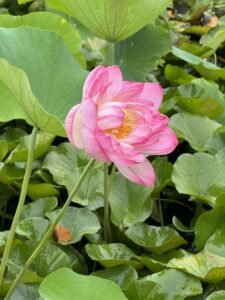Ashtanga Yoga Invocation
I originally wrote this in DC Ashtanga’s first year being open. After a year of not chanting the invocation, you may have noticed that we’ve returned to it. Are you curious about what we’re chanting?
I’m not throwing myself under any buses by admitting to you that I was resistant to even just “omming” for quite some time. I owe our own Dr. Madeline Miskie a world of gratitude for helping me get more comfortable sharing my voice this way with you guys– so If you’re a bit nervous to chant aloud, please know your not alone.
Can I tell you story?
When I stayed at the Sivananda Ashram, we chanted every morning and evening with our community. I sorta liked this, because they would occasionally have tambourines, and I reckon I like tambourines. Later in the day, we had chanting *class.* Basically, Swami Sita and her harmonium. The harmonium reminded me of a bleating cat. There were no translations. No tambourines. I was a miserable asshole. I learned to chant and sleep at the same time.
Have you ever heard the story of the curious man and the chanters? Not so long ago, there was a man walking down Paradise Island’s beach when he comes upon a huge, solid wooden fence. On the side of the fence is a big ol’ “Om” symbol– you know the one. Clearly he had stumbled onto an ashram or some other yogic place!
From within the walls, he can hear the residents chanting, “One-oh-Eight! One-oh-Eight! One-oh-Eight!” Over and over he hears them saying it, and as he walks towards the end of the fence, he just can’t help but wonder to himself why on earth they’re chanting “108!” non-stop.
Could it be a special ceremony? Are they counting mala beads? Perhaps its some sort of weeeeird esoteric meditation?! Like any man of strong curiosity, he couldn’t keep his intrigue to himself any longer– he searches for a hole in the fence so as to see what’s going on inside.
After much searching, he spots a small hole just a few feet ahead. The hole is low in the fence and he has to kneel down to peer inside. He moves into position and peeks into the hole. As he looks in, someone inside pokes him in the eye! Then everyone inside the ashram starts chanting, “One-oh-Nine! One-oh-Nine! One-oh-Nine!”
(joke horribly retold from jokebuddha)
For my the majority of my time at the ashram, I was worried I was going to be poked in the eye at best and indoctrinated into a cult at worst.
Many moons later, and I was practicing ashtanga yoga and occasionally people would chant before they practiced. Not a lot of led chanting to be found at the Ashtanga Yoga Center– happy Michael. I managed to luck out of learning the Ashtanga Yoga invocation until *I* actually got interested in it.
Learning what the chants mean, what their imagery implies, and what we’re doing when we chant became enjoyable and accessible. For me, it started with learning what the heck we were chanting and realizing that I could use the imagery without having to assign belief to anything.
Lo and behold, these days I even make it to a few chanting clasess in Mysore. Sometimes with Lakshmish (these are ‘compulsory’ at the KPJAYI) and other times with the Professor Jayashree in Lakshmipurum..
I know that some of you have been curious about the meaning– so here you go. I gathered a word for word translation from Rolf Steiner, and it is presented here with my commentary.
Om
Vande Gurunam Charanaravinde
Sandarshita Svatma Sukava Bodha
Nih Sreyase Jangalikayamane
Samsara Halahala Mohashantyai
Abahu Purushakaram
Shankhacakrsi Dharinam
Sahasra Sirasam Svetam
Pranamami Patanjalim
Om
- vande = (1. pers. sg. of vand) praise
- gurūṇāṁ = (gen. pl.) great teacher, master, guru
- caraṇā = (pl.) feet
- ravinde = (loc. sg.) Lotus
Praise for the guru, aka the dispeller of darkness. Not just any guru, either, a BIG guru. As a sign of my respect, this praise is offered up to him at his lotus feet. Don’t worry, this isn’t the weird part: touching your teacher’s feet is a thing people do in some places. Because he’s awesome, he’s sitting in lotus, no problem.
- san = (non konjuktional) offer, give
- darśita = (past passive particip) uncover
- sva = own
- ātma = the own self
- sukhāvabodhe = (loc. sg.) joyful awakening
Why the big love? Because he’s given us the power to uncover our own real, true, self. And that true self is made of bliss, so this awakening away from darkness is just incredible.
- niḥ = (reinforcing part.) very, thorough
- śreyase = (dat. sg. m.) well-being, happiness, joy
- jāṅgali = jungle
- kāyamāne = One who has knowledge about healing, who heales, a healer, shaman
- jāṅgali-kāyamāne = jungle shamans.
It’s so powerful, in fact, that this happiness and joy might as well have come from a jungle physician. I know, it seems crazy, but at the time of this chant, jungle physician’s were the most knowledgeable kind of doctor around! Take that, Kaiser. Also: still not the weird.
- saṁsāra = Conditioning, wheel of cause and result
- hālāhala = most awful conceivable poison
- moha = deceit, deception, illusion
- śāṁtyai = (imperativ pass. sg. from śāṁt) ease, calm down
But what makes the knowledge so powerful? It eases us from suffering due to the poison of conditioned existence. You know, all the little things we believe that may or may not be true that cloud our understanding of our own self and our own joy. Something that steals your joy and your bliss and hides who you are is the WORST kind of poison. Gross. Give me some EASE, PLEASE.
- ābāhu = upper body
- puruṣa = (m.) human being, man, soul
- ākāram = (acc. of ākara) shape, appearance, form
This describes the jungle doc, or Patanjali. He needs the upper body of a man, because he’s got stuff to carry. Spoiler Alert: he’s lugging around the tools for yoga. Sometimes, karma yoga is sometimes described as skill in action. These things are going to need to be wielded with SKILL to take ACTION.
- śhaṁkha = (acc.) mussel horn. The horn symbolises the tone that is considered to be the original tone and the basis of all that is.
- cakra = (acc.) Wheel, Discus. The Chakra represents infinity
- asi = (acc.) Sword, because sword represents the power of differentiation.
- dhāriṇam = holding, carrying
So, what things? The jungle doc/patanjali has in his arms a horn that makes the oldest and deepest of sounds (creating the universe, calling you to practice, om, etc), a sword that discerns (cuts through bullshit), and a discus that represents infinity (you’ve got the time).
- sahasra = 1000
- śirasaṁ = (akk. sg.) Head
- śvetaṁ = (akk. sg.) white, bright
We know the crazy jungle doc is supposed to be imagined as Patanjali (the guy who wrote the yoga sutras and the book on sanskrit grammar). And, not only is he imagined as a jungle doc, he’s also got a thousand white serpent heads, so you know he’s crazy powerful. *bwoop bwoop!* weird alert! *bwoop bwoop* We made it this far, and now they’re sneaking in the weird. THATS why the said he showed up with the torso of a man. Because he has crazy snake heads. Got it. Moving along.
- praṇamāmi = (1. pers. sg.) I bow
- patañjalim = (akk. sg.) to Patanjali, the Author of the Yoga-Sutra.
I bow to you, Patanjali. Even if you do have crazy creepy serpent heads. YIKES!
So, there you have it. The opening chant. I love the outling of our weaponry against the poison of samsara. I’m not convinced Patanjali had a thousand snake heads for real. I do believe that conditioned existance is a thing: and i am reminded every day that it’s the thing we’re battling.
By the way, Patanjali means “to catch a falling prayer.” Isn’t that pretty?
Watch out for your eyes.


